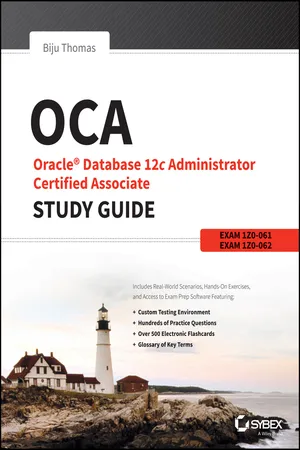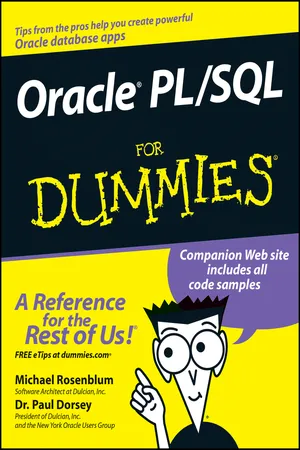Computer Science
Oracle Database
Oracle Database is a relational database management system developed by Oracle Corporation. It is known for its scalability, security, and high performance. It allows users to store and retrieve data efficiently, and it supports various data types and complex queries. Oracle Database is widely used in enterprise environments for managing large volumes of data.
Written by Perlego with AI-assistance
Related key terms
3 Key excerpts on "Oracle Database"
- eBook - ePub
OCA: Oracle Database 12c Administrator Certified Associate Study Guide
Exams 1Z0-061 and 1Z0-062
- Biju Thomas(Author)
- 2014(Publication Date)
- Sybex(Publisher)
Chapter 1Introducing Oracle Database 12c RDBMSOracle Database 12c: SQL Fundamentals exam objectives covered in this chapter:- Introduction
- Describe the features of Oracle Database 12c .
- Describe the salient features of Oracle Cloud 12c .
- Describe Oracle server’s implementation of RDBMS and object relational database management system (ORDBMS).
Organizations and individuals collect and use a variety of information (data). A database collects data, stores and organizes data, and retrieves related data used by a business. Oracle is the world’s most widely used database management system. With the release of its Database 12c , Oracle has enhanced the capabilities of its feature-rich database to include cloud architecture. The c in 12c stands for cloud computing. From Oracle version 8 onward, Oracle includes the core emphasis of the release along with the version number in its name. Versions 8 and 9 are called i to indicate Internet computing; versions 10 and 11 are called g for grid computing.With the cloud enablement, Oracle Database 12c lets you manage many databases as one, thereby reducing overhead and valuable resource consumption.This chapter will introduce you to the Oracle Database 12c high-level components and how the Oracle Database is organized. You will also learn about the relational and object capabilities of the database, and the tools available for database administrators (DBAs) to retrieve information and manage the database.Exam objectives are subject to change at any time without prior notice and at Oracle’s sole discretion. Please visit Oracle’s Training and Certification website at http://www.oracle.com/education/certification for the most current exam objectives.Relational Database Management Systems
A database management system (DBMS) controls the storage, organization, and retrieval of data. In a DBMS, the kernel code is the software piece that manages the storage and memory component of the database. There is metadata in the DBMS that keeps track of all the components of the database, also known as the dictionary. The code or language used to retrieve data from the database is known as SQL, which stands for Structured Query Language - eBook - ePub
- Michael Rosenblum, Paul Dorsey(Authors)
- 2011(Publication Date)
- For Dummies(Publisher)
Database Management system (DBMS): This is the Oracle software itself. This software is installed on the database server. You must have this installed prior to creating a database.Database: A database is primarily a set of tables and data that constitute the persistent (permanent) information for your system. You will also store many other things in the database such as code, indexes (to help queries run faster), and so on. Most of the interesting things you can do with a database (for example, Java classes, snapshots, and links to other databases) are beyond the scope of this book.When you install the database software, Oracle gives you the option of installing a sample database. If you take advantage of this option, it can help you get started.Application server: This is the computer where your application code is stored and executed. Now that most application development is done for the Web, you need a place to store and execute these programs. Those programs are usually executed on an application server. They can also be run on any common operating system, but are usually run on Microsoft Windows or UNIX.Application server software: To make applications work on an application server, you need special software to manage and run those programs. Various products that are available can do this. The most commonly used products are Orion and Apache. In an Oracle environment, you often see Oracle’s own application server, called Internet Application Server (IAS), which is an extension of the Orion server software.Client computer and software: - Ying Bai(Author)
- 2012(Publication Date)
- Wiley-IEEE Press(Publisher)
A transaction is a logical group of SQL statements that carry out a unit of work. Client Server databases use log files to keep track of transactions that are applied to the database. For example, before an update is applied to a database, the database server creates an entry in the transaction log to generate a before picture of the data in a table and then applies a transaction and creates another entry to generate an after picture of the data in that table. This keeps track of all the operations performed on a database. Transaction logs can be used to recover data in case of crashes or disasters. Transaction logs are automatically maintained by the SQL Server.2.8.3 Oracle Databases
Oracle was designed to be platform independent, making it architecturally more complex than the SQL Server database. Oracle Database contains more files than SQL Server database.The Oracle DBMS comes in three levels: Enterprise, Standard, and Personal. The Enterprise edition is the most powerful and is suitable for large installations using large number of transactions in a multiuser environment. Standard edition is also used by high-level multiuser installations. It lacks some of the utilities available in Enterprise edition. Personal edition is used in a single-user environment for developing database applications. The database engine components are virtually the same for all three editions.Oracle architecture is made up of several components, including an Oracle server, Oracle instance, and an Oracle Database. The Oracle server contains several files, processes, and memory structures. Some of these are used to improve the performance of the database and ensure database recovery in case of a crash. The Oracle server consists of an Oracle instance, and an Oracle Database. An Oracle instance consists of background processes and memory structures. Background processes perform input/output and monitor other Oracle processes for better performance and reliability. Oracle Database consists of data files that provide the actual physical storage for the data.2.8.3.1 Data Files
The main purpose of a database is to store and retrieve data. It consists of a collection of data that is treated as a unit. An Oracle Database has a logical and physical structure. The logical layer consists of tablespaces, necessary for the smooth operation of an Oracle installation. Data files make up the physical layer of the database. These consist of three types of files: data files which contain actual data in the database; redo log files , which contain records of modifications made to the database for future recovery in case of failure; and control files , which are used to maintain and verify database integrity. Oracle server uses other files that are not part of the database. These include a parameter file that defines the characteristics of an Oracle instance, a password file used for authentication, and an archived redo log
Index pages curate the most relevant extracts from our library of academic textbooks. They’ve been created using an in-house natural language model (NLM), each adding context and meaning to key research topics.


